May 14 2021
Performance | Noé Martínez and María Sosa: El encuentro de los tepalcates
Fri | 7PM

Swiss Institute is pleased to present El encuentro de los tepalcates, a new performance work by Mexico City-based artists Noé Martínez and María Sosa. In September 2020, Martínez and Sosa commenced a virtual residency with Swiss Institute as part of the Clarice Oliveira Tavares Residency for artists based in Latin America. This performance marks the culmination of nine months of remote dialogue between SI and the artists.
Both Martínez and Sosa, who share a studio and home, maintain independent artistic practices that trouble complex histories of colonization in the Americas and propose new strategies for resistance and healing. Both artists work across media, conducting field research and engaging pre-Columbian traditions to make art that sensitively articulates how the dissonance between history and memory embeds itself in bodies and lives. In this new collaborative endeavor, they explore how language, objects and physical movement can coalesce into liberatory force.
The program begins with Curar es existir, a short video made by Martínez and Sosa that documents a series of decolonial experiments conducted in their studio over the last year. While visiting a street market in Brussels in 2019, the artists bought several archival copies of L’llustration congolaise, a Belgian photo magazine of colonial propaganda that circulated from 1924 to 1940. Following this chance acquisition, Martínez and Sosa brought the documents back to Mexico City where they remained in storage. In the video, these issues of L’llustration congolaise are methodically destroyed. The brittle and yellowed pages are torn, soaked and pulverized into a pulp that the artists infused with tobacco, a crop used by the Huastec people for ritual, therapeutic and protective purposes. From this mixture, Martínez and Sosa formed a paper mask. Documentation of this transformation is interspersed with footage of Sosa holding the mask to her face, improvising movements propelled by both ruinous and restorative energies.
The video is followed by a live performance in which Martínez and Sosa wear hand-dyed fabric sculptures inscribed with lines of poetry, ancient texts and critical theory and adorned with fragments of metal and bone. The choreographies enacted by the artists build upon personal ritualistic traditions, invoking the natural world to establish interspecies, cross-temporal connections. Driving the action is a rhythmic score that showcases the indigenous chants of a rezadora (one who prays) recorded by Martínez and Sosa in the Catedral de San Cristóbal de las Casa in Chiapas. In moments of pause and in hope of ancestral communion, Martínez and Sosa announce themselves in Nahuatl and Purépecha, respectively, and read aloud the words inscribed on the other’s body.
Please RSVP to rsvp@swissinstitute.net. Please note that this performance will be held on the roof terrace of Swiss Institute and that capacity is very limited. Visitors are required to wear masks at all times and to keep six feet apart from other attendees.
